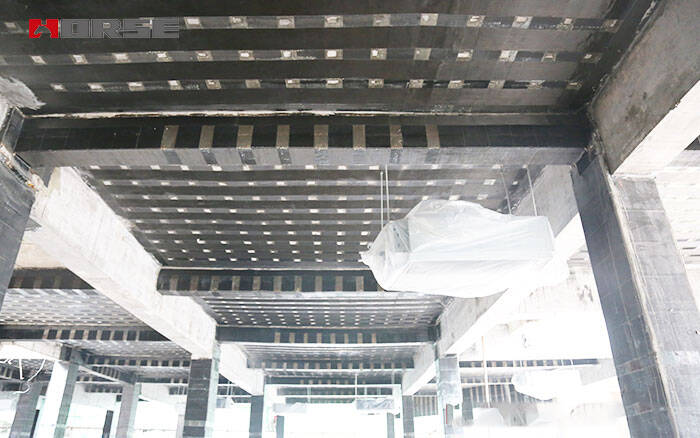Solutions
Horse Construction offers full range of structural strengthening materials with technical supports, documentation supports, products supports, project supports.
Evaluation of carbon fiber strengthening engineering performance

1 Carbon fiber material performance evaluation
The modulus of elasticity of carbon fiber is close to that of steel, which is very suitable for the reinforcement and repair of reinforced concrete structures. At the same time, the tensile strength of carbon fiber is 10 times that of ordinary steel. Under the condition of achieving the same reinforcement effect, the amount of carbon fiber is much less than that of steel.
The weight of carbon fiber is only 200~300g/m2, which is about 1/100 of that of 3mm thick steel plate. It hardly increases the weight of the structure and does not cause chain reinforcement of the structure.
According to relevant data, in a weak acid environment, after 10,000 freeze-thaw cycles, alternating dry and wet, a certain light time, and soaking in hot water at 70 degrees Celsius for 30 days. The durability, corrosion resistance, and aging resistance of carbon fiber are not reduced, and the fatigue strength remains 80%.
2 Evaluation of technical and economic performance of carbon fiber reinforced engineering
Compared with traditional reinforcement technology, carbon fiber reinforced concrete technology has good economic performance. Although on the surface, the price of carbon fiber materials is relatively higher, when actually used in reinforcement projects, the overall cost is lower. The carbon fiber reinforcement project does not require large construction machinery and auxiliary machinery, saving the cost of shifts. Carbon fiber is a lightweight and flexible material, which is easy to construct and reduces labor costs. Carbon fiber has good corrosion resistance and does not require regular maintenance, saving maintenance costs. When carbon fiber is used in batches, the price of its materials is also declining.
3 Evaluation of the applicable scope of carbon fiber strengthening engineering
From the perspective of mechanical performance, carbon fiber has high tensile strength and fatigue performance. It is mainly suitable for the reinforcement of the tension area of concrete members, especially for the seismic reinforcement of large and medium-sized structures that are subjected to dynamic loads such as bridges. From the perspective of material characteristics, carbon fiber is a flexible coil. According to construction needs, it can be processed into U-shape or round shape, which can be used for compression and shear reinforcement of structural beams, columns, etc., to prevent and repair temperature cracks in walls, and to improve the seismic resistance of brick masonry structures. From the perspective of practical application, the carbon fiber reinforced concrete technology avoids the disadvantages of other reinforcement methods such as increasing the structure size, reducing the building space, increasing its own weight, long construction period, and poor corrosion resistance. At present, it has been widely used in the reinforcement of bridges, roads, underground structures, towering high-rise structures, industrial plants and other building structures.
4 Evaluation of technical characteristics of carbon fiber strengthening engineering
As a secondary combined structure, the reinforced structure improves the load-bearing capacity of the building through the overall work of the old and new parts. Compared with the traditional enlarged section method, outer steel plate method, winding steel wire method, and prestress method, the carbon fiber reinforced concrete technology does not need to perforate the concrete structure, will not cause structural reinforcement damage, and there is no need to worry about the stress concentration at the old and new joints of the structure. And weaken the reinforcement effect. Compared with the more advanced bonding steel plate reinforcement technology, carbon fiber reinforcement does not require auxiliary machinery, the construction is simple, the effective bonding area is easy to guarantee, and the construction efficiency is higher. Compared with glass fiber and nylon fiber reinforcement technology, carbon fiber has higher specific modulus, higher specific strength, flexibility, corrosion resistance, and aging resistance, so that the ductility of carbon fiber reinforced components has a higher degree of improvement. Moreover, the scope of application is wider and the use life is longer.
Carbon fiber materials are more and more widely used in structural strengthening reinforcement projects. Among the existing reinforcement methods, carbon fiber materials are generally recognized for their excellent mechanical properties, simple construction technology and good effects.
You can find anything here you are in need of, have a trust trying on these products, you will find the big difference after that.